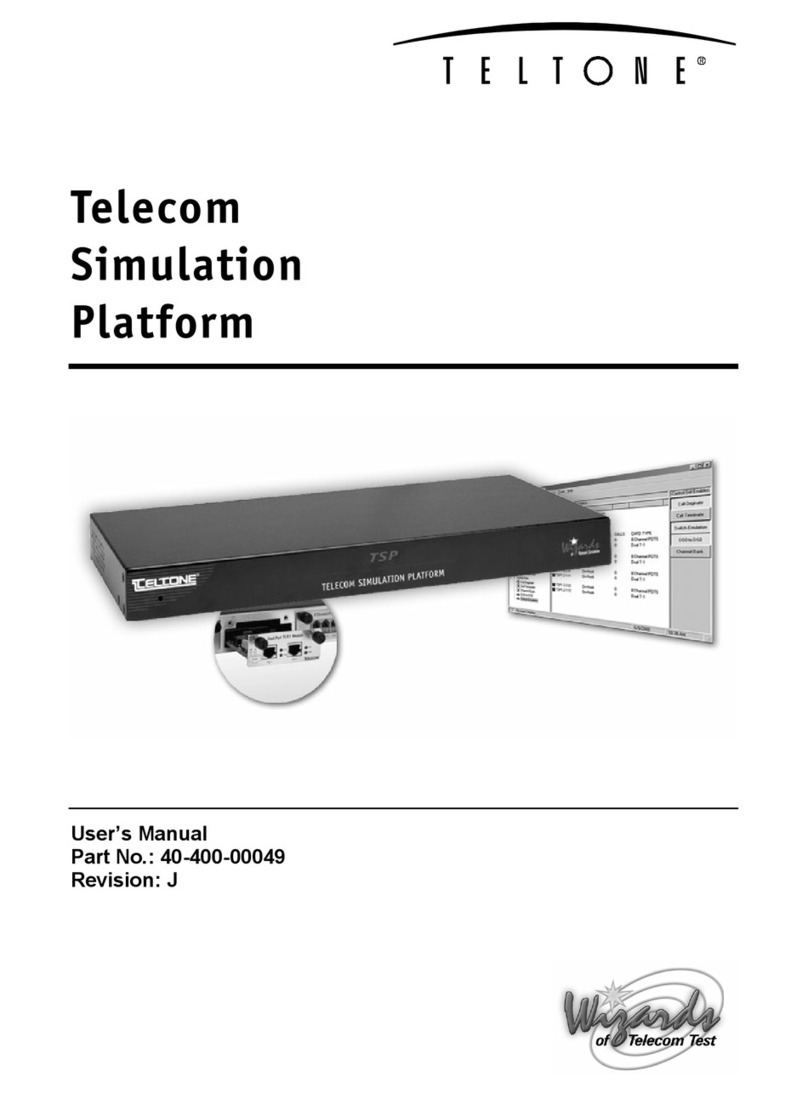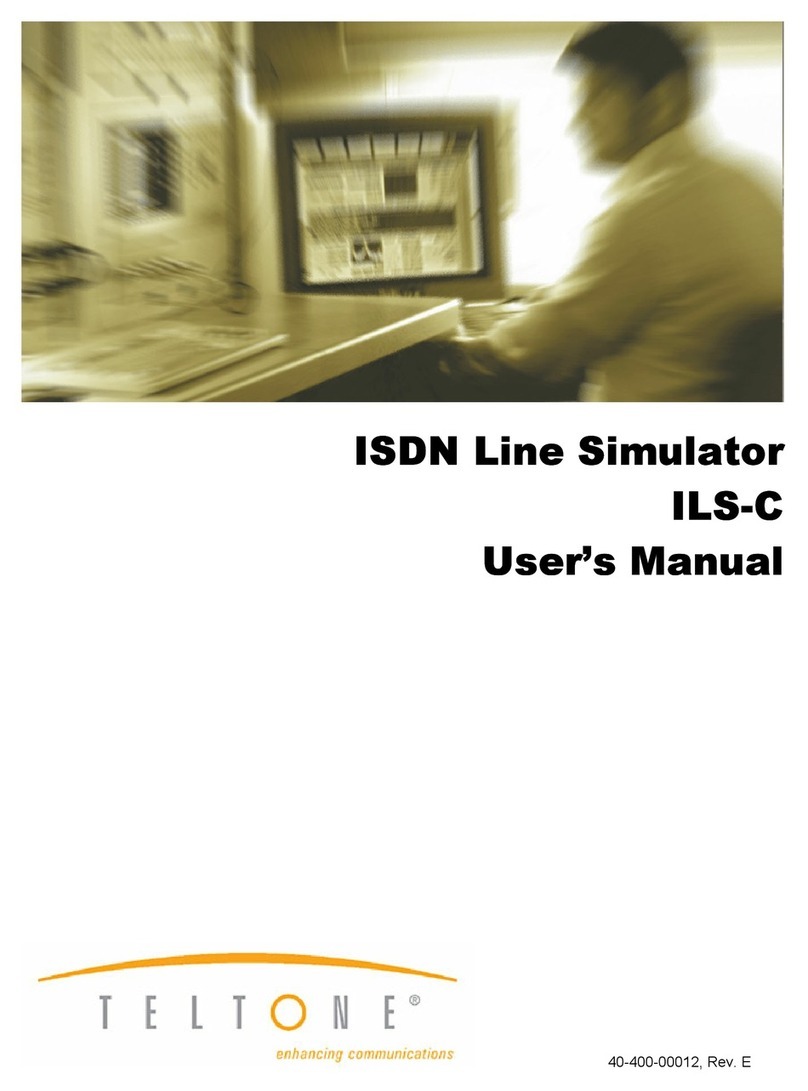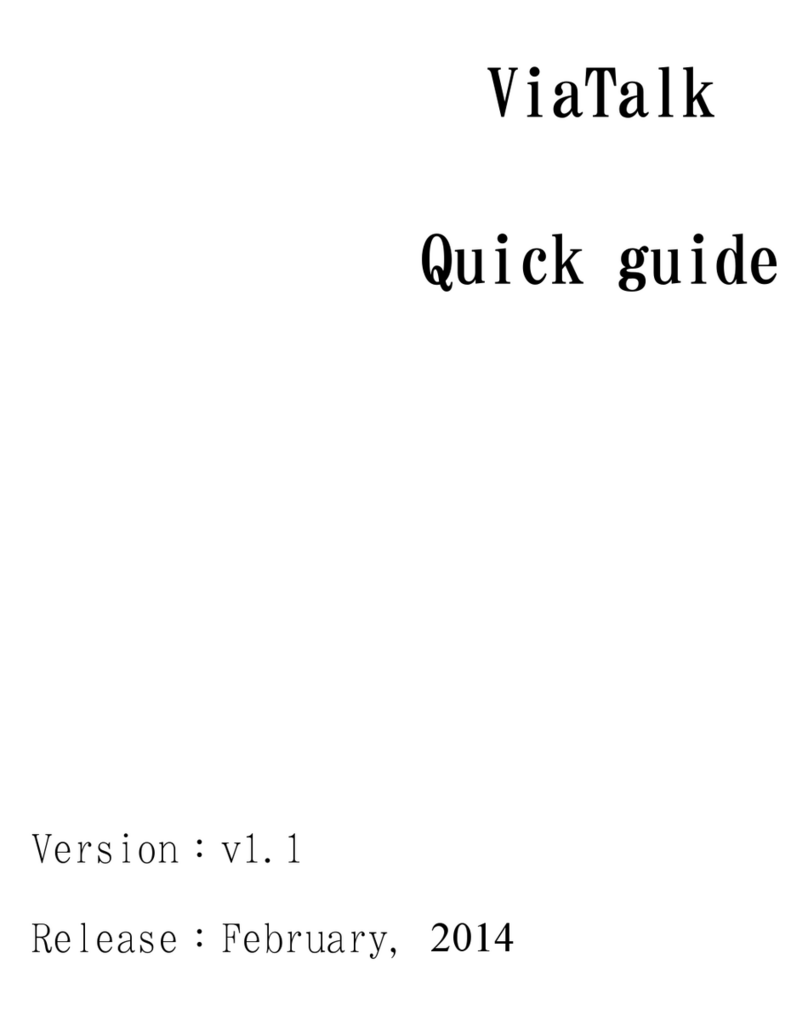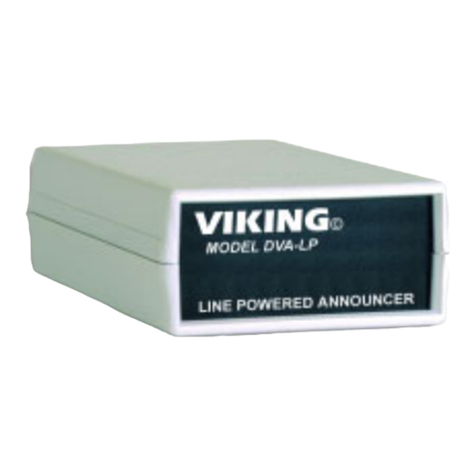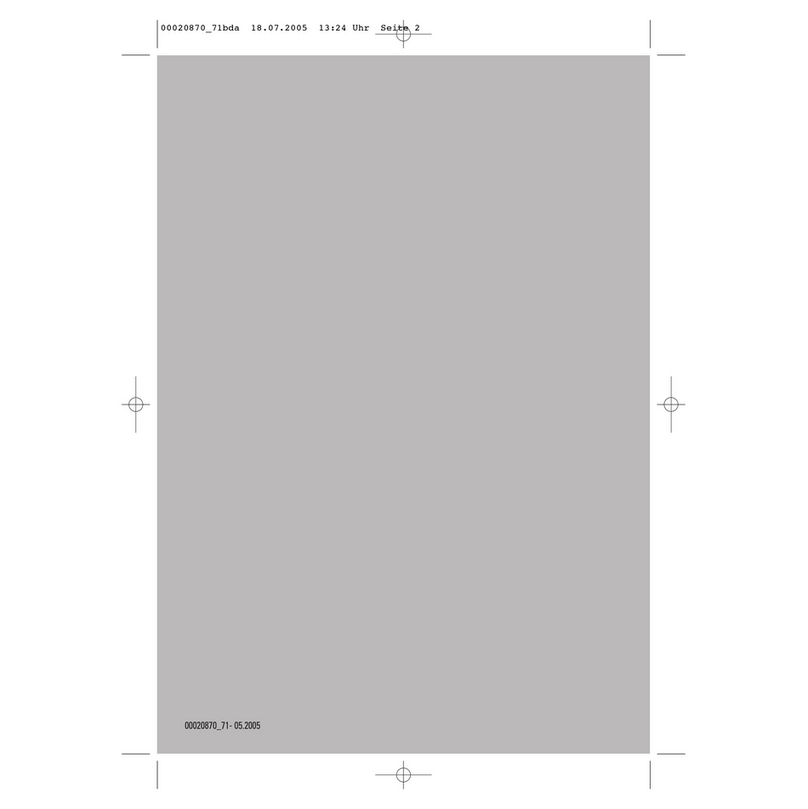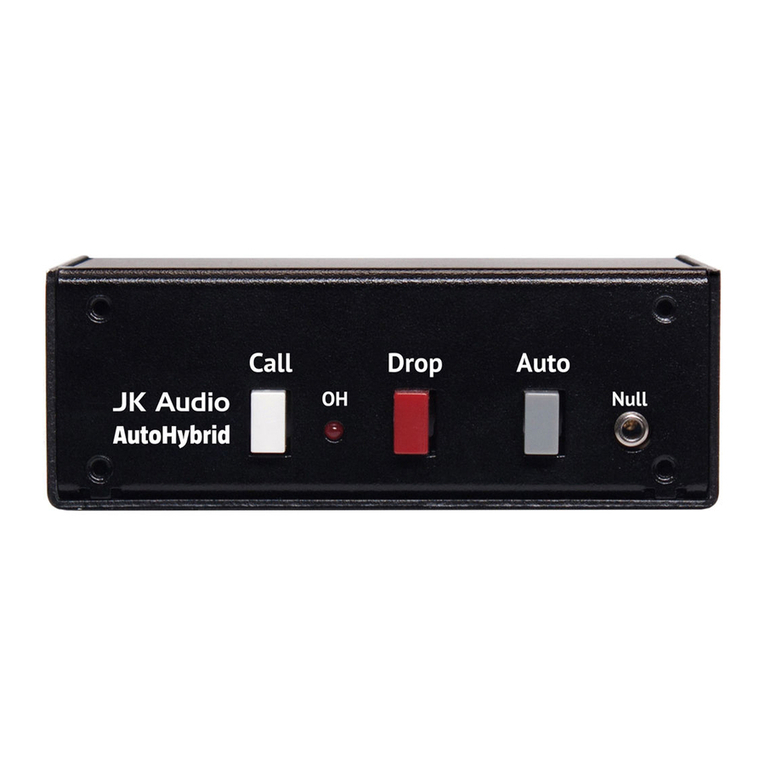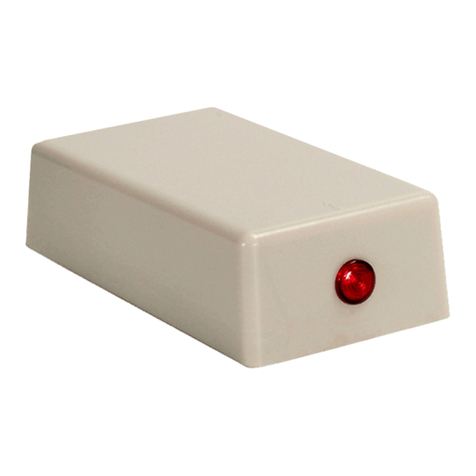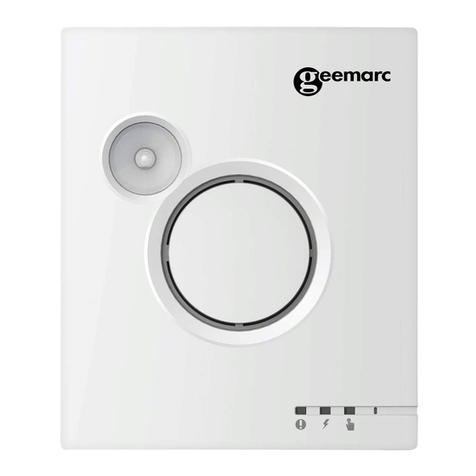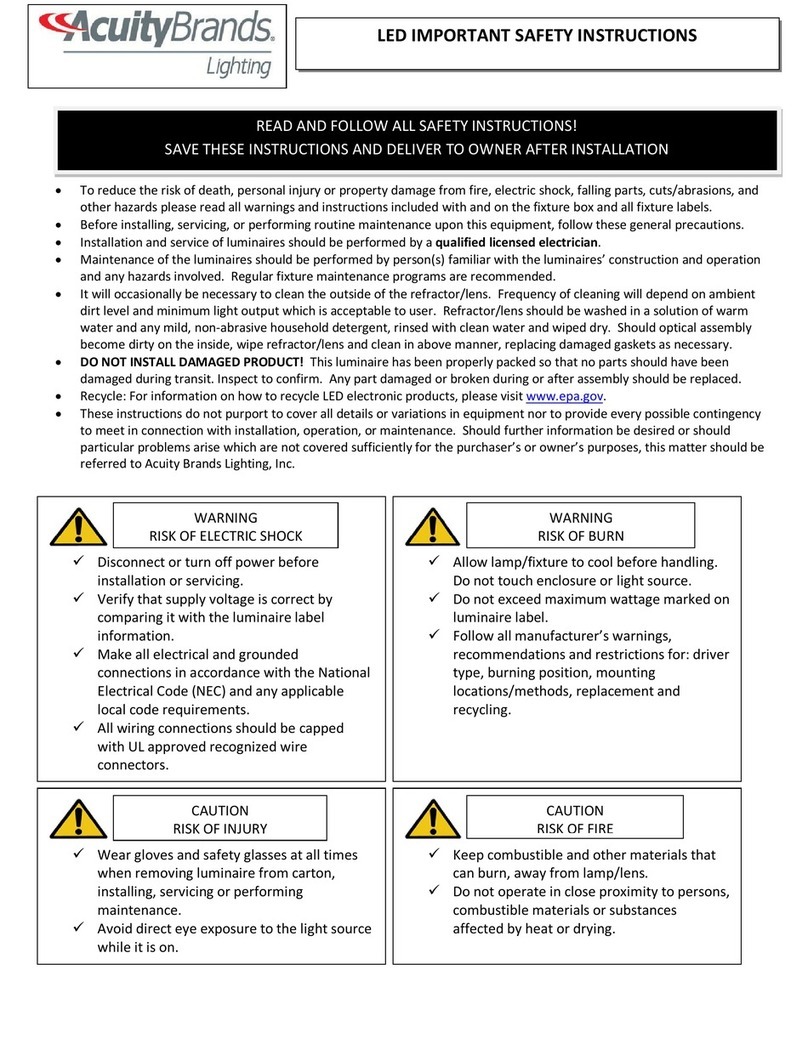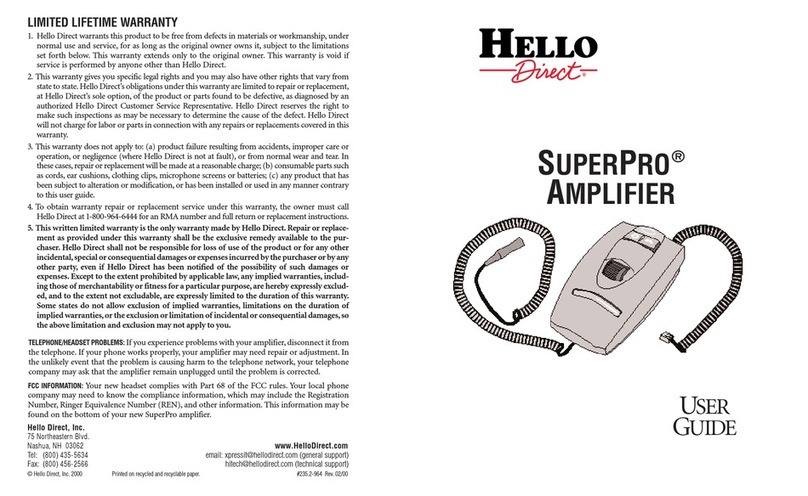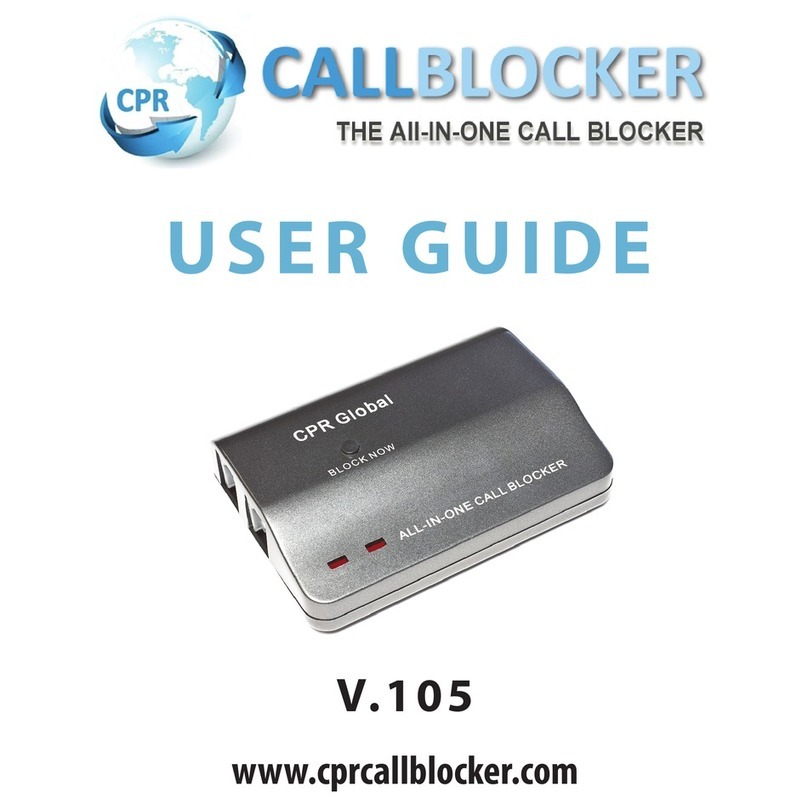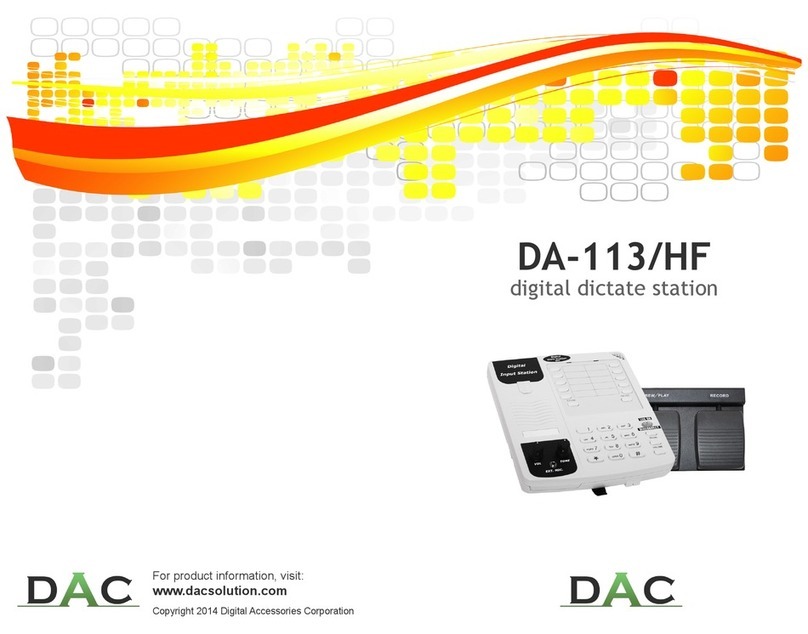Teltone TLE-A User manual

Telephone Line Emulator
TLE-A
User’s Manual
40-400-00020, Rev. M

ii 40-400-00020, Rev. M
Note
This manual covers Model TLE-A-01 and software modules TLE-ADV (Advanced Emulation),
TLE-INTL (International), and TLE-ICID (International Caller ID).
Copyright Notice
Copyright © 1997 - 2003 Teltone Corporation
All Rights Reserved
Trademarks
Teltone is a registered trademark of Teltone Corporation.
Windows is a registered trademark of Microsoft Corporation.
Other company and product names may be trademarks or
registered trademarks of their respective owners.
Teltone Corporation
Bothell, Washington 98021 USA
Customer Service: 425-951-3388
Technical Support: 425-951-3390
Fax: 425-487-2288
Website: www.teltone.com

40-400-00020, Rev. M iii
Contents
Overview ...................................................................................................................................................................1
Standard Unit Features (TLE-BASE) ...............................................................................................................1
Options ............................................................................................................................................................1
International Software Module (TLE-INTL).................................................................................................1
International Caller ID Software Module (TLE-ICID) ..................................................................................2
Advanced Emulation Software Module (TLE-ADV) ....................................................................................2
Automated Test Software Module (TLE-TEST)..........................................................................................2
TLE Front and Rear Panels .............................................................................................................................3
Getting Started ..........................................................................................................................................................4
Check your TLE Package ................................................................................................................................4
Product Registration ........................................................................................................................................4
Setting up the TLE.....................................................................................................................................................5
Power up the TLE ............................................................................................................................................5
Installing the TLE Configuration Software........................................................................................................5
TLE Operation .................................................................................................................................................6
Basic Calling Operation ...................................................................................................................................9
Configuring the TLE ................................................................................................................................................10
Main TLE Screen ...........................................................................................................................................11
Copy Configurations ......................................................................................................................................12
Operational Screens................................................................................................................................................14
Audio Line Monitor.........................................................................................................................................14
Busy Tone......................................................................................................................................................15
Call Waiting....................................................................................................................................................16
Caller ID - Visual Message Waiting ...............................................................................................................18
Advanced Screen Telephony.........................................................................................................................22
DC Signaling..................................................................................................................................................22
Dial Tone .......................................................................................................................................................24
Loop Parameters ...........................................................................................................................................25
Miscellaneous ................................................................................................................................................26
Phone Numbers.............................................................................................................................................28
Port Configuration..........................................................................................................................................30
Reorder..........................................................................................................................................................31
Ringing...........................................................................................................................................................32
Special Information Tones/Number Unobtainable Tone ................................................................................33
Voice Messages ............................................................................................................................................34
References ..............................................................................................................................................................35
Advanced Emulation Software Module (TLE-ADV) .................................................................................................36
Impairments ...................................................................................................................................................36
Metering Tones..............................................................................................................................................37
Signal Level Measurement ............................................................................................................................38
International Software Module (TLE-INTL)..............................................................................................................39
Rotary Dialing ................................................................................................................................................39
References ....................................................................................................................................................40
Reset to Defaults ...........................................................................................................................................40
Country Screen..............................................................................................................................................41
Importing Additional Countries.......................................................................................................................41
Call Waiting....................................................................................................................................................42
Metering Tones..............................................................................................................................................43
Special Information Tones/Number Unobtainable Tone ................................................................................43
Loop Parameters (TLE-INTL) ........................................................................................................................45
Country Default Settings ................................................................................................................................45
Australia Defaults .....................................................................................................................................46
Austria Defaults........................................................................................................................................47
Belgium Defaults ......................................................................................................................................48
Brazil Defaults ..........................................................................................................................................49
China Defaults..........................................................................................................................................50
Denmark Defaults ....................................................................................................................................51
Finland Defaults .......................................................................................................................................52
France Defaults........................................................................................................................................53

iv 40-400-00020, Rev. M
Contents
(Continued)
Germany Defaults ....................................................................................................................................54
Greece Defaults .......................................................................................................................................55
India Defaults ...........................................................................................................................................56
Ireland Defaults ........................................................................................................................................57
Italy Defaults ............................................................................................................................................58
Japan Defaults .........................................................................................................................................59
Korea Defaults .........................................................................................................................................60
Netherlands Defaults................................................................................................................................61
Norway Defaults.......................................................................................................................................62
Singapore Defaults...................................................................................................................................63
Spain Defaults..........................................................................................................................................64
Sweden Defaults ......................................................................................................................................65
Switzerland Defaults ................................................................................................................................66
UK Defaults..............................................................................................................................................67
US/Canada defaults .................................................................................................................................68
International Caller ID Software Module (TLE-ICID)................................................................................................69
Introduction ....................................................................................................................................................69
Overview - TLE-ICID......................................................................................................................................69
Details of Operation .......................................................................................................................................70
Caller ID Timing Parameters..........................................................................................................................73
Programming .................................................................................................................................................74
Caller ID and Call Waiting Modes ............................................................................................................74
Caller ID and CIDCW Components and Sequence..................................................................................76
Caller ID Miscellaneous Parameters ........................................................................................................80
Phone Number Prefix and Group Selections ...........................................................................................81
Caller ID and Call Waiting Tones .............................................................................................................83
DTMF CID Parameters ............................................................................................................................84
Timings ....................................................................................................................................................86
Australia Defaults...........................................................................................................................................90
France Defaults .............................................................................................................................................92
Germany Defaults..........................................................................................................................................94
Netherlands Defaults .....................................................................................................................................96
Singapore Defaults ........................................................................................................................................97
Sweden Defaults............................................................................................................................................98
UK Defaults....................................................................................................................................................99
US/Canada Defaults ....................................................................................................................................101
References ..................................................................................................................................................102
Automated Test Software Module (TLE-TEST) .....................................................................................................104
Automated Test Screen ...............................................................................................................................104
Revision History ....................................................................................................................................................106
Troubleshooting.....................................................................................................................................................110
Errors on Power-up......................................................................................................................................110
Informational and Error Messages...............................................................................................................111
Telephone Wiring Variants...........................................................................................................................114
Warranty and Service ............................................................................................................................................116
Warranty Information ...................................................................................................................................116
Return Procedures.......................................................................................................................................116
Technical Assistance ...................................................................................................................................116
Maintenance ................................................................................................................................................116
Ordering Information .............................................................................................................................................117
Specifications ........................................................................................................................................................118
Glossary ................................................................................................................................................................123
Index .....................................................................................................................................................................128

40-400-00020, Rev. M v
IMPORTANT SAFETY INSTRUCTIONS
When using this product, basic safety precautions, including the following, should always be followed to reduce the risk of
fire, electric shock, and injury to persons.
1. Read and understand all instructions.
2. Follow all warnings and instructions marked on the product.
3. The product should be operated only from the type of power source indicated on the marking label. If you are not sure
of the type of power supply, consult your dealer or local power company. The product is designed for indoor use only.
4. To reduce the risk of electric shock, do not disassemble the product, but take it to qualified service personnel when
service or repair work is required. Opening or removing covers may expose you to dangerous voltages or other risks.
Incorrect reassembly can cause electric shock when the appliance is subsequently used.
5. If the product does not operate normally by following the operating instructions, or if the product has been dropped or
the cabinet has been damaged, or if the product exhibits a distinct change in performance, refer servicing to qualified
service personnel.
6. If the product is used in a manner other than specified in this manual, the protection provided by the product may be
impaired.
7. For the purpose of removing power from the product, the power input connector is the main power disconnect point.
Pull the power cord away from the connector to ensure power disconnect.
8. Adequate air flow must be maintained in order for the product to operate correctly. Do not wrap the product in
blankets, paper, or other material that may impede ventilation.

vi 40-400-00020, Rev. M
REGULATORY COMPLIANCE
FCC Part 15 Class A Notice: This equipment has been tested and found to comply with the limits
for a Class A digital device, pursuant to part 15 of the FCC Rules. These limits are designed to
provide reasonable protection against harmful interference when the equipment is operated in a
commercial environment. This equipment generates, uses, and can radiate radio frequency energy
and, if not installed and used in accordance with the instruction manual, may cause harmful
interference to radio communications. Operation of this equipment in a residential area is likely to
cause harmful interference in which case the user will be required to correct the interference at his
own expense.
The Installation Category (OVERVOLTAGE CATEGORY) for this device is II and it is designed to
be safe under POLLUTION DEGREE 2, per IEC 1010-1: 1990 specifications.

Telephone Line Emulator User’s Manual
40-400-00020, Rev. M 1
Overview
The Teltone Telephone Line Emulator (TLE) is a user-configurable four-port analog
telephone emulator, enabling simulation of many public switched telephone network
(PSTN) conditions. The TLE is designed to work between 100 VAC and 240 VAC,
enabling the TLE to be used worldwide. There is an International Software Module, an
Advanced Simulation Software Module, an Automated Test Software Module, and an
International Caller ID Software Module available. These options are designed to work
individually with the basic TLE, or they can be mixed and matched depending on the
user’s requirements.
Standard Unit Features (TLE-BASE)
• Two user-selectable configuration settings
• 2 x 2 port or 4 port operation
• Vacuum Florescent Display for telephone port status information and other messages
• 600 or 900 ohm programmable input impedance
• Programmable ring frequency, ringback tones, voltage, and cadence
• Programmable loop current
• Programmable DC signaling (on/off-hook, flash, disconnect and line reversal)
• Programmable attenuation
• Three programmable numbers for each line
• Call Waiting, Visual Message Waiting, Stuttered Dial Tone
• Caller ID, SCWID (Caller ID in Call Waiting), and DSCWID (SCWID with Disposition
• Programmable dial tone, busy tone, reorder tone, and special information tones (SIT)
• Five dial-up test tones plus one programmable test tone
• Calling Party Control, network delays, dialing mode, and other miscellaneous settings.
• Audio Messaging, Import WAV files from the PC, Multiple Message Playback
• 100 to 240 VAC power supply
• CE Mark Compliance
• Programming via Windows-based software using a serial port
• 3.5 mm mono audio jack for monitoring audio
Options
International Software Module (TLE-INTL)
Basic unit features plus:
• 16 stored configuration settings which include:
• 11 predefined Country specific settings
• 5 preset North America settings
• 11 additional Country settings included
• Programmable 12 or 16 kHz metering tones
• Ability to call from one country configuration to another
• Complex impedances for Australia, Ireland, Germany, UK, and Switzerland

Telephone Line Emulator User’s Manual
40-400-00020, Rev. M2
International Caller ID Software Module (TLE-ICID)
This module is an upgrade to TLE-INTL Software Module.
• Supports Multiple Caller ID formats
• Bellcore
• Bellcore Plus
• ETSI FSK
• ETSI DTMF
• Default Country Caller ID Configurations for:
• Australia (Bellcore Plus)
• France (ETSI FSK)
• Germany (ETSI FSK)
• Netherlands (ETSI DTMF)
• Singapore (Bellcore Plus)
• Sweden (ETSI DTMF)
• United Kingdom (ETSI FSK)
• USA/Canada (Bellcore)
• Many programmable parameters
Advanced Emulation Software Module (TLE-ADV)
Basic unit features plus:
• 16 stored configuration settings
• Echo emulation
• White noise emulation
• Satellite delay emulation
• Signal level measurement
• Enable Caller ID after every ring
• Enable/Disable DTMF detection (for pulse dial only applications)
• Metering tones
Automated Test Software Module (TLE-TEST)
Basic unit features plus:
• Control of TLE through serial port using API commands
• Ability to write customizable scripts for repetitive testing
• API definitions in both Visual Basic and C++ formats
• Programmable frequency sweep tone
• Status messages on front panel and through serial port
• Includes access to International and Advanced Emulation features
• Designed specifically for product development and production test applications
• International Caller ID features available with installation of TLE-INTL and TLE-ICID
software modules

Telephone Line Emulator User’s Manual
40-400-00020, Rev. M
3
TLE Front and Rear Panels
Figure 1. Telephone Line Emulator Front and Rear Panels

Telephone Line Emulator User’s Manual
40-400-00020, Rev. M4
Getting Started
Check your TLE Package
Your basic package should include the following items:
• TLE-A-01 unit
• 110 VAC power cord for use in North America
• 9-pin male to 9-pin female RS-232 cable
• 9-pin male to 25-pin female adapter
• CD-ROM containing configuration software and User Manuals
• Product Registration Card
The following items may be included as options:
• International Software Module (TLE-INTL)
• International Caller ID Software Module (TLE-ICID) - Requires purchase of the
International Software Module.
• Advanced Emulation Software Module (TLE-ADV)
• Automated Test Software Module (TLE-TEST)
• 7-foot modular telephone cable
• 25-foot modular telephone cable
• 9-pin male to 9-pin female RS-232 cable (1 supplied with each TLE unit)
• 9-pin male to 25-pin female adapter (1 supplied with each TLE unit)
• 7.5 foot 110 VAC power cord (1 supplied with each TLE unit)
If any of the items you ordered are missing or damaged, contact Teltone’s Customer
Service at 425-951-3388.
Product Registration
Please complete the Product Registration card and mail it to Teltone Corporation. This will
place you on the mailing list for information regarding feature enhancements and product
upgrade information.

Telephone Line Emulator User’s Manual
40-400-00020, Rev. M
5
Setting up the TLE
Power up the TLE
The TLE uses a universal power supply that operates from 100-240 VAC, 50/60 Hz.
Connect AC power to the TLE, then turn the rear panel power switch to the ON position.
Grounding is assured by using the appropriate (approved) power cord.
The green Status LED on the front panel will indicate the state of the system. The LED
should blink between mid-to-full brightness. If the LED fails to light, disconnect power
immediately and contact Teltone Technical Support at 425-951-3390.
Adequate air flow must be maintained in order for the unit to operate correctly. Do not
wrap the unit in blankets, paper, or other material that may impede ventilation.
Installing the TLE Configuration Software
The TLE Serial Port uses a standard RS-232 DCE interface. Using the cable provided,
connect the TLE to a personal computer running a Windows-based operating system.
(Optional with PC-software V2.00 or greater.)
Windows 95 or Later Versions
1. Insert the CD-Rom into the drive.
If the installation automatically starts, skip to step 4.
2. On the TaskBar, left click START, then RUN.
3. Type in your drive designator, followed by Setup.exe
example: r:\setup.exe
4. Follow the instructions on the screen to complete the installation.
5. Confirm that the correct communications port is configured. PC-Software V2.00 and
greater will automatically display the TLE-Comm Port selection screen if the TLE is not
connected or uses a port other that Comm1. Select the appropriate port and then
Detect. The TLE software will test to see if your TLE is connected. The control leads
status are shown at the bottom of the window. If the TLE is connected with the proper
cable; all should be green. If not; CTS, DSR, and CD are normally red. Select Cancel
if your TLE is not connected at this time. Select OK to complete the CommPort
selection.

Telephone Line Emulator User’s Manual
40-400-00020, Rev. M6
Figure 2. TLE - Comm Port Screen
Windows 3.1 and Windows 3.11 (Windows for Workgroups)
1. Insert the CD-Rom into the drive.
2. Using the Windows Program Manager, Select File, Run.
3. Type in your drive designator, followed by Setup.exe
example: r:\setup.exe
4. Follow the instructions on the screen to complete the installation.
5. Confirm that the correct communications port is configured. PC-Software V2.00 and
greater will automatically display the TLE-Comm Port selection screen if the TLE is not
connected or uses a port other that Comm1. Select the appropriate port and then
Detect. The TLE software will test to see if your TLE is connected. The control leads
status are shown at the bottom of the window. If the TLE is connected with the proper
cable; all should be green. If not; CTS, DSR, and CD are normally red. Select Cancel
if your TLE is not connected at this time. Select OK to complete the CommPort
selection.
TLE Operation
The following call process flowchart will help to explain the basics of call setup and
completion. More detailed explanations are included after the flowchart.

Telephone Line Emulator User’s Manual
40-400-00020, Rev. M
7
Figure 3. TLE Call Processing Flowchart (Part 1)

Telephone Line Emulator User’s Manual
40-400-00020, Rev. M8
Figure 4. TLE Call Processing Flowchart (Part 2)

Telephone Line Emulator User’s Manual
40-400-00020, Rev. M
9
Basic Calling Operation
The Teltone TLE provides dial tone (Normal – default), or Ringdown (Hotline), or a quiet
battery feed (Silent), when a device goes off-hook and draws sufficient loop current. When
dialing is detected, DTMF or Pulse (aka Rotary dialing), dial tone stops. If an invalid
sequence is dialed, the TLE will issue an Invalid Number Response of SIT + Audio
(default), SIT repeating, Busy, Reorder, Ringback, Silence, or Audio. If a valid number is
dialed, a Hunt Mode of Ring All (default), Ring 1st match, Ring 1st available, or Ring next,
is invoked. Caller ID information is sent to the Called Party, along with Ringing, and
Ringback tone is sent to the Calling Party. When the called line answers, a connection is
established between the two parties.
During an existing call, another party may go off-hook and dial a number that matches one
of the connected parties. If so, then a SAS (Call Waiting tone) + CAS (Caller ID tone) is
issued to the called party. If the called party has a Caller ID box or phone that supports
SCWID (aka Caller ID in Call Waiting), then the Caller ID information will be issued by the
TLE. If the called party does not answer the waiting call, a repeat of the Call Waiting tone
occurs ten seconds after the first. During an existing call, either party may wish to
Transfer/Conference another party. To accomplish this, the originating party must
generate a hook flash, after which the TLE will return a Confirmation Dial Tone, and the
originating party will dial the number of a third party. After connecting to the third party, all
three are brought together with another hook flash. Conference operation is dependent
upon the setting of the Conference Type in the Miscellaneous Screen.
The end of a call uses Calling Party Control. If the Called Party hangs up, the connection
may be re-established if they go off-hook before the Forced Disconnect Timer expires. If
the Calling Party goes on-hook, or if the Forced Disconnect Timer expires, then a Forced
Disconnect signal, a break in the loop current, is sent to the remaining party if they are off-
hook. After a Forced Disconnect signal is sent, and the party remains off-hook, then
Disconnect Treatment is invoked. The options include Dial Tone (default), Busy, Reorder,
Silence, or an Audio message.
The TLE supports a few special dialing sequences. These include:
Special Caller ID dial ∗67 + telephone number to send PRIVATE
dial ∗87 + telephone number to send OUT OF AREA
dial ∗88 + telephone number to send Checksum error
Speed Dialing dial 1#, 2#, 3#, or 4# to access lines 1,2,3, or 4 respectively
Visual Message Waiting dial ∗50 + telephone number to turn VMW ON
dial ∗51 + telephone number to turn VMW OFF
DTMF Programming dial ∗∗99##
Set Active Configuration dial ∗xx#, where xx is the configuration #
Version Query dial ∗99#, view display for versions
Special Telephone Numbers (programmable) include:
Audio Access Message dial 411
Dial Tone (continuous) 83781 (TEST1)
Busy (continuous) 83782 (TEST2)
Reorder (continuous) 83783 (TEST3)
Ringback (continuous) 83784 (TEST4)
Special Test Tone (continuous) 83785 (TEST5)
Stuttered Dial Tone (continuous) 83786 (TEST6)

Telephone Line Emulator User’s Manual
40-400-00020, Rev. M10
Configuring the TLE
Using the Configuration Software, different configurations can be saved to download to
the TLE. A configuration contains all the programmable parameters of the TLE. The
standard TLE (TLE-BASE) unit can have 2 different configurations, while the add-on
software modules can have up to 16 different configurations.
The Active Configuration is the configuration that is being used by the TLE. Any
configuration may be selected as the Active Configuration using the Configuration
Software, or an ASCII command string via the serial port, or a DTMF dialing sequence
from a device connected to a port. See below for more information.
A Configuration Set is a file name given to reference the configurations saved. Only one
Configuration Set can be downloaded to the TLE, although multiple Configuration Sets
can be saved on the PC.
Editing a configuration may be done off-line, or while connected to the TLE. While
connected to the TLE, changes made are updated in the TLE by either selecting the
APPLY or OK button on each screen. Using the APPLY button will implement the
changes but keep the current screen to allow for any additional changes. Using the OK
button will implement the changes, exit the screen and return to the Main screen. If the
update is to the Active Configuration, every update will cause the display of the TLE to
show “Initializing Configuration” and then “Active Configuration” and then the configuration
number. The TLE must be in the idle state (all lines on-hook) for the update to occur. If
the update is to a configuration that is not currently active, the TLE display will not change.
When the TLE_PC software is run, it will read the Unit Name and the Active
Configuration of the TLE and display them on the Main screen of the software. If there is
no TLE connected, the title bar will read TLE_PC - No Unit Connected. If there is a TLE
connected and the Configuration of the TLE does not match the default configurations in
the software, a screen will appear asking whether you want to query the TLE for its
configuration settings. In addition, any time the TLE is initially connected, the software
will automatically query the unit for firmware version information. If the software has an
updated version, it will ask you if you want to download the new code.
Reset
On the front panel of the TLE there is a recessed button called Reset. Pressing this
button for greater than 1 second once will display a prompt asking. “Reset all configs?
Press Reset = yes”. Pressing Reset a second time for greater than 1 second will reset the
TLE configuration memory to the factory default settings with Configuration 1 active.
When the front panel Reset button is pressed, the unit will be reset to the US/Canada
defaults for all configurations. The user must perform Defaults and Send All from the PC
configuration software to reload the defaults for each individual country configuration.
Selecting Active Configuration using DTMF
All other ports must be on-hook and the dialing sequence is as follow: go off-hook, dial
∗∗99## to enter Programming Mode, then dial ∗xx#, where xx is the configuration
number. For example, to select configuration 02, dial ∗02# and the TLE will respond with

Telephone Line Emulator User’s Manual
40-400-00020, Rev. M
11
a three beep confirmation tone (if enabled), and the display will show the new
configuration following an initialization sequence. If an error in the entry occurs, the TLE
will respond with a single beep error response.
Selecting Active Configuration using the serial port
The Active Configuration may be selected via the serial port with PC_TLE software 2.00 or
greater. This is accomplished by setting up the serial port at 9600 baud, 8 data bits, 1
stop bit, no parity, hardware flow control, and sending an ASCII string to change the
Active Configuration. The format of the message to the TLE is either:
:XX<cr> or,
:XX,YY<cr>
The TLE will respond with !OK if the command is accepted or !ERR if it is rejected.
:XX will set the active configuration from 01 to 16 for all 4 ports and :XX,YY will set the
active configuration XX for ports 1 and 3 and YY for ports 2 and 4.
Note: Local echo of command characters is not provided by the TLE.
Main TLE Screen
The top section of the main TLE screen displays the Active Configuration Number,
Name, and Date/Time it was created, if a TLE is connected. This field will be blank if no
TLE is connected. It also shows the current Configuration Set Name and the Date/Time
it was created. The Set Active button allows the user to choose the Active Configuration
in the TLE.
Figure 5. Main TLE Screen (No TLE Connected)
The middle section of the screen displays the Configuration being edited. The Name
button allows the user to change the name of each configuration. The Send button sends
the current configuration being edited to the TLE. The Send All button sends all of the

Telephone Line Emulator User’s Manual
40-400-00020, Rev. M12
configurations in the Configuration Set to the TLE. The Query button will query the
settings for the current configuration in the TLE. The Query All button will query all of the
stored configurations in the TLE. The Defaults button will reset any Configuration under
edit to the factory default settings.
The bottom section displays buttons that conform to the natural order of call placement
and pressing any of these buttons will bring up windows with information regarding the
operation of the TLE. Another method to use when changing the operation of the TLE is
to use the Screens menu on the menu bar. All of the screens are displayed in
alphabetical order. A Find button is also supplied to help with locating the parameter to
be changed.
The bottom line of the Main screen will report three items:
1) The name of the saved file under edit.
2) If the Configuration Set under edit matches what is stored in the TLE, Set=TLE will be
displayed. If the Configuration Set does not match, Set<>TLE will be displayed.
3) If the Configuration being edited matches the configuration stored in the TLE,
Configuration=TLE will be displayed. If not, then Configuration<>TLE will be displayed.
The Screens menu is used to change the settings of the operational features of the TLE.
These are broken into individual screens labeled as Audio, Busy, Call Waiting, Caller
ID, DC Signaling, Dial Tone, Loop Parameters, Miscellaneous, Phone Numbers, Port
Configuration, Reorder, Ringing, Special Information Tones, and Voice Messages.
Other screens that are active if the TLE-INTL, TLE-ADV, or TLE-TEST software modules
are purchased include Country, Metering Tones, Impairments, Signal Level
Measurement, and Automated Test. The TLE-ICID Software Module combines Call
Waiting and Caller ID into a single screen called Caller ID/Call Waiting.
Copy Configurations
The Edit menu is used to copy settings from one configuration to another, or to copy the
settings from one Line to another by using the Copy Configuration and Copy Line
commands found in the Edit Configuration menu.
Figure 6. Copy Configuration Screen

Telephone Line Emulator User’s Manual
40-400-00020, Rev. M
13
Figure 7. Copy Line Screen

Telephone Line Emulator User’s Manual
40-400-00020, Rev. M14
Operational Screens
Audio Line Monitor
The Audio port on the front of the TLE is used to monitor the AC signals on any one of the
lines of the TLE when this feature is enabled. Only one line may be monitored at a time.
The audio line monitor port is a 3.5 mm miniature audio jack.
Figure 8. Audio Screen
Recorded Messages
The Recorded Messages portion of the Audio screen, together with the Voice
Messages screen, allows the selection of recorded messages for playback.
There are three conditions defined for playback: Invalid phone Number dialed,
Audio message on Disconnect, and message for Dial Access. There are four
messages which may be stored. The default names (see Voice Messages
screen) are: Invalid Number, Disconnect, Dial Access, and Alternate. Any of
these four names may be selected for the three conditions with the Audio
screen.
When one of the conditions for playback occurs, the recorded message plays
one time, followed by silence. If the Repeat selection is checked, the audio
message will repeat continuously.
The TLE ships with one default message for each of the three conditions. These
messages are stored in a mono 8 kHz, 8-bit µ-law WAV file format. Their names
are: Invalid.WAV, Hangup.WAV, and Dialacc.WAV. The user may create new
files using a sound card. Double clicking on the File field in the Voice Messages
screen allows the selection of a new file. The TLE-PC software stores these in
0.5 seconds increments and displays the total file length on the screen. The sum
This manual suits for next models
4
Table of contents
Other Teltone Telephone Accessories manuals
